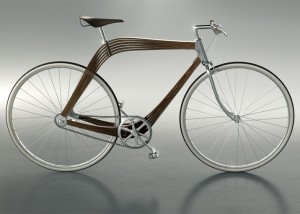While a bicycle and a building are at opposite ends of the spectrum in terms of function and scale, some of the principles that underpin their structural integrity are essentially the same.
This means that the construction of the wooden bicycle serves as an excellent means for exploring methods for creating stronger building structures using thin timber sheets.
“The bicycle is perfect to test how wooden structures work in different scales with different loads,” said Atanas Zhelev, one of a team architects responsible for the development of an innovative new timber vehicle.
Zhelev and colleagues Martino Hutz and Mariya Korolova first devised the idea of the bicycle while designing a wooden house at the University of Applied Arts Vienna.
According to Zhelev the design of the house piqued the interest of structural engineering experts.
In order to better test the structural innovations of their own technology, the architects opted develop a bicycle made using similar principles.
The pedal-powered vehicle produced in collaboration with bike manufacturer AERO is made from lamellas – sheets of birch wood that measure under a millimetre in thickness.
These thin sheets are glued together in vertically stacked strips to form the bicycle’s innovative frame structure, consisting of two curved, boomerang-shaped beams that form a shape akin to an open mouth.
The beams thicken slightly at certain parts for increased structural support – such as at the point where the pedals are attached, and beneath the metal tubing that props up the bike seat.
The architects were able to use this bike frame to explore methods for improving the structural robustness of buildings made from the same material.
One of the chief methods for increasing structural integrity uncovered by the team of architects is adjusting the positioning of the individual timber strips.
The architects found that they could increase structural strength by aligning the strips of lamella based on their natural grain.
According Mr Zhelev, the use of this specific layering technique confers multiple advantages compared to conventional timber building methods, including reduced weight, heightening flexibility and increased strength.
The timber bike frame possesses sufficient strength and flexibility to dispense completely with a conventional suspension system employing tightly coiled springs.
In addition to these structural advantages, the use of the layering principle for the production of timber materials is also far more economical than the conventional method of milling lumber blocks, which according to Mr Zhelev results in the wastage of large amounts of wood.






